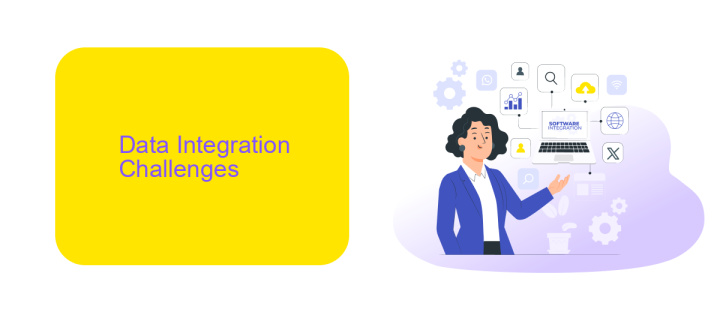Integration Data
In today's data-driven world, the ability to seamlessly integrate diverse data sources is crucial for organizations aiming to make informed decisions. Integration Data focuses on the methodologies, tools, and best practices that facilitate the consolidation of data from various platforms, ensuring accuracy, consistency, and accessibility. This article explores the importance of data integration and its impact on business intelligence and operational efficiency.
Introduction
Integration of data has become a cornerstone in the modern business landscape, enabling seamless communication between disparate systems and enhancing operational efficiency. By automating data flows, organizations can reduce manual efforts, minimize errors, and ensure real-time data availability. This process is particularly crucial for businesses looking to stay competitive and agile in a rapidly evolving market.
- Streamlined workflows through automated data transfers
- Reduced manual data entry and associated errors
- Enhanced data accuracy and consistency
- Real-time data synchronization across multiple platforms
- Improved decision-making capabilities
One of the leading solutions for setting up and managing data integrations is ApiX-Drive. This service offers a user-friendly interface and robust functionality, allowing businesses to connect various applications effortlessly. ApiX-Drive supports numerous integrations, making it a versatile tool for organizations aiming to optimize their data workflows without extensive technical expertise. By leveraging such services, companies can focus on their core activities while ensuring their data is always up-to-date and accurately synchronized.
Data Integration Challenges

Data integration presents several challenges that can complicate the process of combining information from multiple sources. One of the primary issues is data inconsistency, where different systems may store the same data in various formats, making it difficult to reconcile and merge. Additionally, data quality can be a significant concern; ensuring that the integrated data is accurate, complete, and up-to-date requires robust validation and cleaning processes. Another challenge is the sheer volume of data, as integrating large datasets can strain system resources and complicate processing.
Security and privacy are also critical challenges in data integration. Ensuring that sensitive information is protected during the integration process requires stringent security measures and compliance with data protection regulations. Moreover, managing real-time data integration can be complex, as it necessitates continuous data flow and synchronization across systems. Tools like ApiX-Drive can help mitigate these challenges by providing automated data integration services that streamline the process, ensuring consistency, quality, and security while reducing the manual effort required.
Data Integration Solutions

Data integration solutions are essential for organizations looking to streamline their operations and enhance data accuracy. These solutions enable seamless data exchange between disparate systems, ensuring that information is consistent and up-to-date across all platforms.
- ApiX-Drive: This service offers a user-friendly interface for setting up integrations without any coding knowledge. It supports a wide range of applications and automates data transfer processes.
- ETL Tools: Extract, Transform, Load (ETL) tools help in gathering data from multiple sources, transforming it into a usable format, and loading it into a central repository.
- Middleware Solutions: These act as a bridge between different systems, facilitating data communication and integration.
Choosing the right data integration solution depends on the specific needs of your organization. ApiX-Drive, for instance, is ideal for businesses looking for a quick and easy setup, while more complex operations may benefit from robust ETL tools or middleware solutions. By leveraging these technologies, companies can ensure data consistency, improve decision-making, and drive efficiency.
Benefits of Data Integration

Data integration is a crucial process for modern businesses, enabling them to combine data from various sources into a single, unified view. This consolidation facilitates better decision-making and enhances operational efficiency. By integrating data, organizations can eliminate data silos and ensure that all departments have access to accurate and up-to-date information.
One of the primary benefits of data integration is the ability to improve data quality. When data from different sources is combined, it is easier to identify and correct inconsistencies and errors. Additionally, integrated data provides a comprehensive view of business operations, allowing for more accurate analytics and reporting.
- Enhanced decision-making capabilities
- Improved data quality and consistency
- Increased operational efficiency
- Better customer insights
- Streamlined business processes
Services like ApiX-Drive make the process of data integration seamless and efficient. ApiX-Drive allows businesses to connect various applications and automate data transfer between them, reducing the need for manual intervention and minimizing errors. This not only saves time but also ensures that data is always up-to-date, enabling businesses to stay agile and responsive in a competitive market.
Conclusion
In conclusion, the integration of data is a critical aspect for modern businesses aiming to streamline operations and make informed decisions. By effectively consolidating data from various sources, companies can gain a comprehensive view of their operations, thus enhancing efficiency and productivity. The ability to integrate data seamlessly not only reduces redundancy but also ensures that the information is accurate and up-to-date, which is essential for strategic planning and analysis.
Tools like ApiX-Drive play a pivotal role in simplifying the process of data integration. By offering a user-friendly platform that supports a wide range of applications, ApiX-Drive enables businesses to automate data flows without the need for extensive technical expertise. This not only saves time but also minimizes the risk of errors, allowing organizations to focus on leveraging their data for growth and innovation. Therefore, adopting such integration services can be a game-changer for businesses looking to stay competitive in a data-driven world.
FAQ
What is data integration?
Why is data integration important for businesses?
What challenges can arise during data integration?
How can automation help in data integration?
What tools are available for automating data integration?
Time is the most valuable resource in today's business realities. By eliminating the routine from work processes, you will get more opportunities to implement the most daring plans and ideas. Choose – you can continue to waste time, money and nerves on inefficient solutions, or you can use ApiX-Drive, automating work processes and achieving results with minimal investment of money, effort and human resources.

